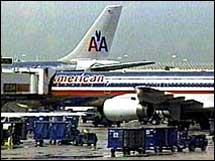|
Flying past $42 billion in losses
After years of battling low-cost rivals and struggling to cut costs, the nation's older airlines are finally expected to post profits this year.
NEW YORK (CNNMoney.com) - After six years and billions in losses, many of the country's biggest airlines are poised to climb out of the red and start making money again. Older carriers such as American Airlines (Research), United Airlines (Research), Continental Airlines and US Airways are still expected to again post a loss for the current quarter. But all are forecast to post a profit in the second quarter and for the full year. None of them have posted an annual profit since 2000.
A huge part of the change in fortunes is rising fares and fuller planes, but efforts by the airlines to cut costs, especially through concession contracts won from union workers, have also been key. It's allowed the carriers to make money even with jet fuel prices more than triple what they were four years ago. "We've got more seats that are filled and we're getting higher fares for them. That's your best case scenario," said John Heimlich, chief economist for the Air Transport Association, an industry group. "If (jet) fuel was at $40 a barrel, we could be minting money right now." Still, Heimlich is projecting that the industry as a whole will lose $2 billion this year before returning to profitability in 2007. He said that even with a 10 percent increase in January and February, fares are still 16 percent below where they were in the first two months of 2001. And even with the debt and pension obligations that some of the carriers have shed, it will take a while for the industry to climb out of $42 billion in net losses from 2001 through 2005. "You can't undo five years of deep losses with one year of modest profit. We've got a long way to go," said Heimlich. Two of the nation's biggest carriers, No. 2 Delta Air Lines and No. 5 Northwest Airlines, are still in bankruptcy proceedings, trying to shed costs. There are also growing problems for some of the upstart low-fare carriers as they struggle with the same high fuel prices and are seeing some of their cost advantages narrow. JetBlue Airways (Research) is expected to be one of the carriers losing money this year after posting its first full-year loss as a public company in 2005. And Southwest Airlines (Research), by far the most profitable during the downturn, is still dependent on long-term contracts that give it fuel at below-market prices for its profits. But as time goes on and fuel prices remain near historically high levels, Southwest will see less advantage from those contracts. "In 12 months we'll be talking about the problems with the low-cost carriers, not the (old line) carriers," said Michael Boyd, an industry consultant. He predicted that the upstart, low-fare carriers will have trouble finding new markets for expansion, while old line carriers are well positioned to take advantage of continued growth in business and international travel. "The revenue streams that American and Northwest and those other carriers will be able to plumb will make up for the higher costs," said Boyd. But Boyd said that even the older carriers are not a good long-term investment. Part of what makes the stocks risky is that many of them have already had a strong run in the last six months. Shares of US Airways (Research) has almost doubled since the airline emerged from bankruptcy and was purchased by the former America West last September. United shares are up 20 percent in the six weeks since they resumed trading in early February with its exit from Chapter 11. And American and Continental (Research) have seen their shares each jump more than 150 percent since October. Still, there are some industry analysts who think the stocks have some room to run. Airline analyst Ray Neidl of Calyon Securities raised his recommendation on American and Continental to a "buy" from an "add" this week, while boosting United and US Air to "add," from a neutral rating. "I still think there are better things to come heading into the summer season," he said. "Airline stocks tend to trade ahead of the season." But even Neidl said he would only see the stocks as a short-term investment. "They'll still be a seasonal and cyclical play," said Neidl. "It's the nature of the industry."
For a look at growing grumbling among airline passengers, click here. |
|

